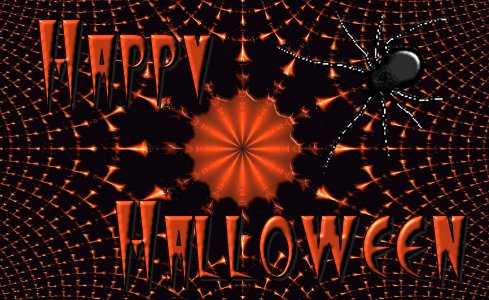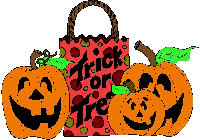




|
Our modern celebration of Halloween is a descendent of the ancient Celtic fire festival called "Samhain". The word is pronounced "sow-in", with "sow" rhyming with cow.
The Celtic people lived about 2,000 years ago in an area which we now
call Ireland, the United Kingdom, and France.
The festival of Samhain marked the end of summer, the harvest
season, and the beginning of their new year.
The Celtic people believed that on the night of October 31st
, the ghosts of the dead returned to earth.
They built huge bonfires and dressed in costumes to frighten the
ghosts.
The Celtics also offered the ghosts good things to eat. The custom of trick-or-treating is thought to have originated not with the Irish Celts, but with a ninth-century European custom called souling. On November 2, All Souls Day, early Christians would walk from village to village begging for "soul cakes," made out of square pieces of bread with currants. The more soul cakes the beggars would receive, the more prayers they would promise to say on behalf of the dead relatives of the donors. At the time, it was believed that the dead remained in limbo for a time after death, and that prayer, even by strangers, could expedite a soul's passage to heaven.
According to the folk tale, after Jack died, he was denied entrance to Heaven because of his evil ways, but he was also denied access to Hell because he had tricked the devil. Instead, the devil gave him a single ember to light his way through the frigid darkness. The ember was placed inside a hollowed-out turnip to keep it glowing longer. The Irish used turnips as their "Jack's lanterns" originally. But when the immigrants came to America, they found that pumpkins were far more plentiful than turnips. So the Jack-O-Lantern in America was a hollowed-out pumpkin, lit with an ember.
The
modern customs of Halloween are similar to the customs of the Celtic
people because many immigrants came to America and brought their beliefs
and traditions with them. The
carving of a Jack-O-Lantern is thought to come from the tradition of
Irish children. They would
carve potatoes or turnips and light them for their Halloween
celebrations. The name Jack
came from an Irish man who people thought was so wicked neither heaven
or the devil wanted him. Jack is thought to have roamed the earth
looking for a place to rest.
Halloween
in America is celebrated on October 31st. The celebrations
are held in towns, schools, churches and homes.
Most children still dress in costumes and continue to trick or
treat in safe neighborhoods or in schools.
Teachers visit Free Worksheets for Halloween
|